Snowdrops are simple, tough plants, yet delicately beautiful. Pioneers of early spring, and appearing whatever the weather, it’s hard not to find snowdrops delightful. They are universally loved and understandably obsessed over by a strong fan-base, known as gallanthophiles. They revel in the intricate variety of shape, blotch variation and colour that the snowdrop family provides.
It’s little wonder that snowdrop walks are so popular at this time of year. Where they grow in huge white masses, like generous frosting on a cake, the impact is joyous.
Recently I have been focussed on using snowdrops to create a lacy edge to the lawn either side of my driveway. The pure white snowdrop finds its perfect foil in a green lawn. So often snowdrops are contained in flowerbeds, tucked away under hedges and trees, or at the far reaches of a lawn. I wanted to bring them into the spotlight. Now, from late January, my car headlights pick out mini pricks of bright white as I come up the drive in the dark evenings. By day the snowdrops soften the edge of the lawn, the green sheet broken by a pretty white filigree.
Two years ago I came dangerously close to falling out of love with the snowdrop. It was a cold January, the sun hadn’t shone for many a day and the sky was overcast and oppressive. The weather wasn’t the only mood-altering factor – my father was living his final few days. As we stood in the grey garden, my brother turned to me and said “how dare the snowdrops look so perky”. Their pure beauty and optimism seemed so at odds with the hopelessness and misery we felt.
A few weeks later, the ice-white snowdrop had melted the gloom and I set about planting hundreds of new plants to give my lawn its new lace collar. They were a connection my father and I wanted to spread them abundantly.
Genuinely no hassle
Snowdrops will work well in most areas, in sun, partial shade or shade. As long as your lawn isn’t baked completely dry every summer, they should do well.
Bulbs naturalised in lawns s definitely a popular gardening trend but when I talk to friends, particularly those with smaller gardens, they don’t like the idea. They are fearful of the messy leaves one must leave to die back before the lawnmower can roam free.
Now, I agree that with daffodils this is a genuine dilemma as they have long strappy leaves, some flop down, some remain fairly upright and all should ideally be left until late May or even June before you can mow. Not so with snowdrops. The leaves are shorter so look less untidy and anyway can be mown back in spring without fear of compromising next year’s flowers. I have never needed to but if you do feel the need to get your mower out sooner, you can always leave the small snowdrop area un-mown for a week or two whilst whilst neatening up the majority of the lawn.
Planting in the green – so easy to do
Snowdrops are best planted ‘in the green’, a phrase that sound technical but which simply means they are planted after flowering, whilst the leaves are still green. This differs from autumn planting of dormant bulbs, which is possible with snowdrops, but which can produce weaker results.
My technique for planting in the lawn involves nothing more than a sharp spade. I have tried bulb planters and trowels but find them fiddly and tough on the wrists. Planting in February, or more usually March, a lawn is likely to be soft and wet so I just jam in my sharp spade to make a slit then wiggle the spade back and forth to widen it. I then make a second at right angles to form a cross shape. The bulbs can then be poked down with your finger, leaves still attached. By planting in a cross shape, you can poke some in at the centre and then more at the extremities to form a mini clump. I then simply press the turf back around them with my boot. Aside from the thin green leaves of the snowdrop poking out, you won’t be able to tell the turf was ever disturbed.
I move randomly about the edge of my lawn planting the groups wherever my spade takes me. Using this method I planted 500 in little over an hour and then retreated inside for a warming cuppa. For the first year or two the clumps have been fairly sparse but are slowly thickening up.
Where to buy snowdrops
If you already have a clump of snowdrops you’re willing to relocate from a bed to a lawn edge, wait until the flowers have faded, go in with your spade and dig the clump up, then separate the bulbs into individuals or small groups ready to replant.
If you have no snowdrops in your garden, they are easy and cheap to buy online from January onwards and sent out to you in February or March. Adverts abound at the back of gardening magazines, or search the web for a supplier. Most will offer the single snowdrop (galanthus nivalis) or a double form with frillier tennis knicker centre. They usually sell in multiples of 50 or 100 and the more you buy, the keener the price.
When it comes to mass plantings in your lawn, the common or garden galanthus nivalis will do the job just fine but there are also specialist suppliers offering some of the astounding 150 varieties of snowdrop to collectors. If you do find the snowdrop bug bites and you want to experiment with a wider variety then look online or in the gardening press for specialist suppliers. North Green Snowdrops (http://www.northgreensnowdrops.co.uk/) and Ashwood Nurseries (www.ashwoodnurseries) caught my eye.
I have also found home growers selling rarer snowdrop bulbs on Ebay. These appear to be reputable sellers who are simply selling bulbs they can spare to fellow enthusiasts. Some individual bulbs are reaching £30 on the online auction site, with no shortage of buyers involved in the bidding.
If you’re looking for a day out, you could also consider going along to a specialist snowdrop fair. Check the gardening press for details or take a look at this helpful summary from the Daily Telegraph (www.telegraph.co.uk)
Sweetly scented – bring some snowdrops into the home
Did you know that snowdrops have a delicate sweet scent? It’s unsuprising that most are unaware of this. Few among us is accustomed to lying in the damp ground in January and February whilst sticking our noses into their tiny flower heads. The solution is to pick some and bring them indoors.
Put into a glass vase or jar of water it can hardly be described as flower arranging and yet it looks so pretty. When picked on a dull day, they will not be open, their closed petals creating a white tear-drop shape. Within a minute or two of being in a warm room, they begin to open to form their delightful downturned tricorn. A few minutes after that the powerful scent will begin to hit you. Make sure when you pick them to use small scissors or flower-arranging scissors as you want to cut only the tiny stem, and not the leaves around them. The leaves add nothing to the vase arrangement and should ideally be left to feed the bulb for next year.
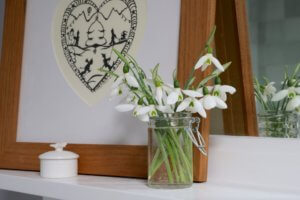
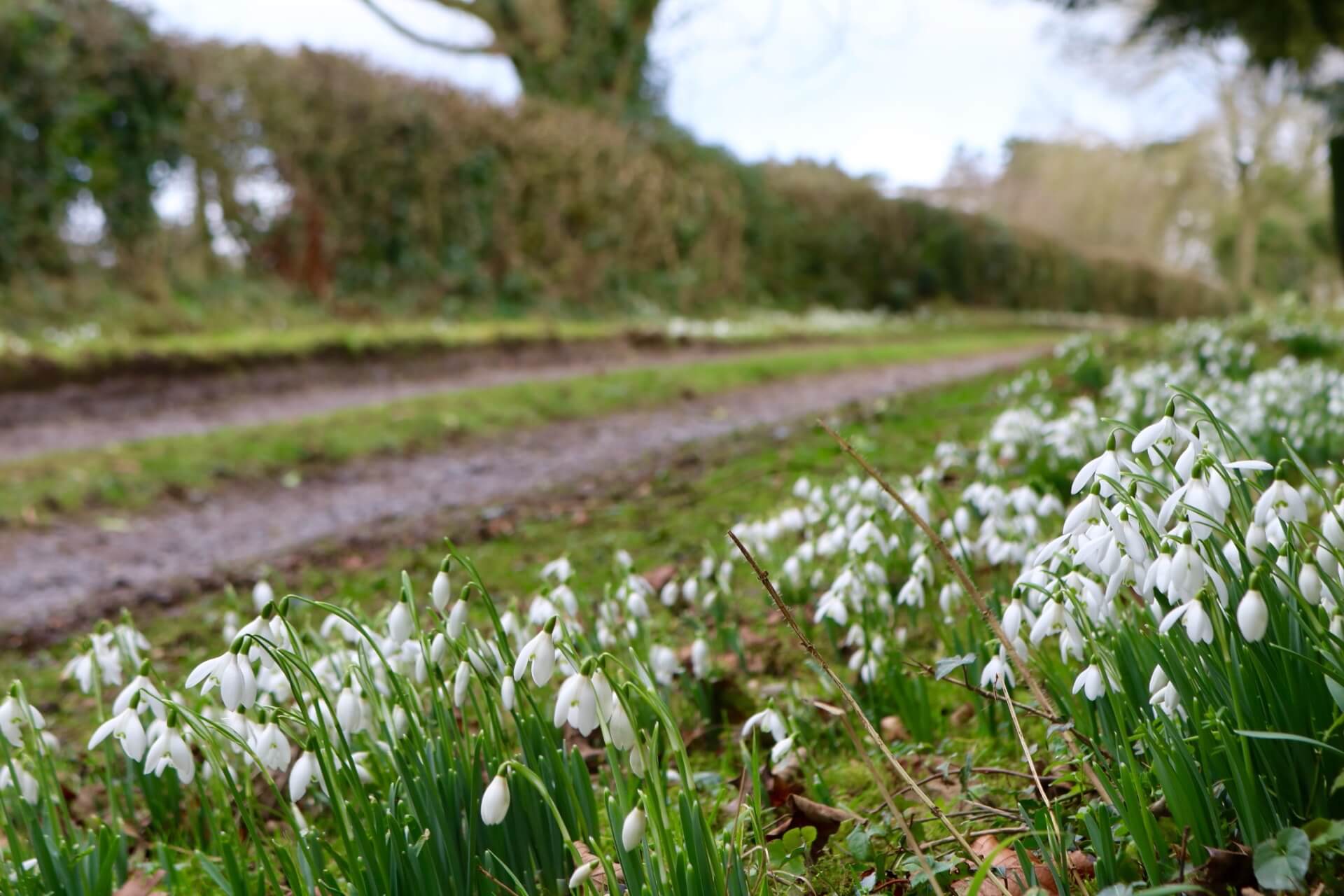
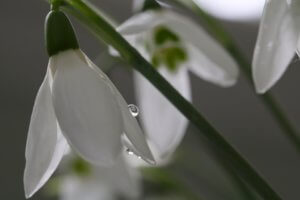
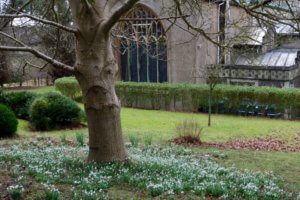
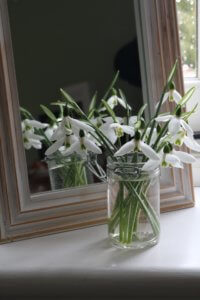
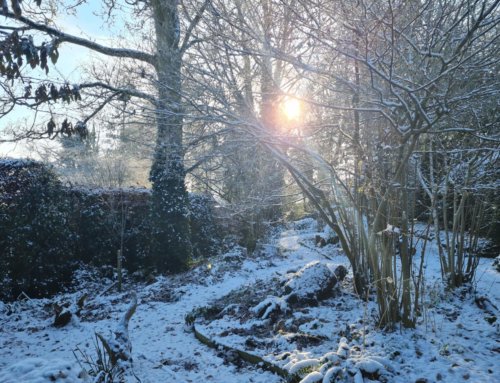
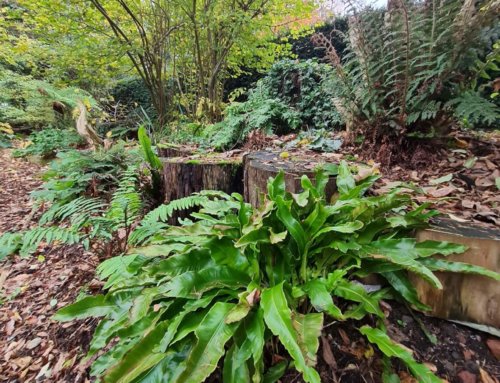
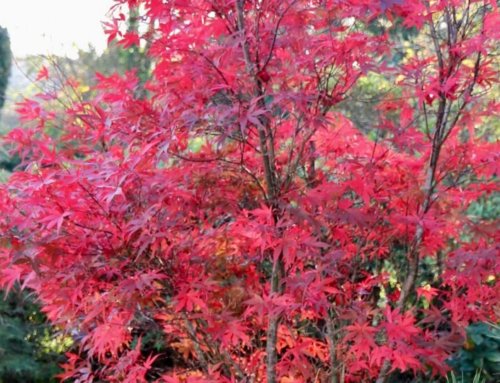
Superb hints, I love the style of your writing.
Thanks Anna. So glad you like it. Is there any room where you live for some new snowdrops?
Will def get some snowdrops planted in the new house. Love this blog … x x
Have just joined and am loving your blog. I am off to buy some snowdrops. xx
Thanks Jo. Now’s a great time. Best to do mail-order if you buy in any quantity.
A wonderful article – I have the common snowdrops (G. nivalis) here, but, sadly, most of my lawn IS baked completely dry every summer, so they need to be planted strategically.
Thanks for your lovely comments Chris and I’m glad you are strategic on your snowdrop planting. This lawn does get dry in a very hot summer but luckily enough moisture is retained to keep the going. What’s amazing is that when I grow snowdrops in pots in a sand plunge the roots are very very long, maybe 30cm, so they obviously can go deep to find moisture.
I wanted to bring some to my dad’s gravesite for his birthday which is what led me here. Reading about your father seemed like I was meant to find the blog. I was looking for a cut bouquet to bring to his gravesite. It will be his first birthday without him and I couldn’t think of a more fitting flower, but no luck. I enjoyed the blog though, informative and touching.
Dear Stephanie, I really appreciate you getting in touch and I know exactly what you’re feeling. It was 5 years ago today that my brother and I had our conversation at the brazen perkiness of the snowdrops. You could always plant some bulbs at his grave so they’ll be there year after year. Now is the perfect time to plant them ‘in the green’. Best wishes.
You say to throw the bulbs on the lawn and plant them where they fall, but you don’t say how to plant them.
I have just the bulbs, no plants yet. Do I dig a many little holes in the grass? Just with a knife? How deep?
I describe how I plant them in the section ‘Planting in the green’. My technique is to use a sharp spade, pushed into the soil and rocked back and forwards to create a narrow trench in which to poke the bulbs. If you’ve got lots of bulbs then yes, you’ll need to dig many trenches or holes where you want to plant them.
My late wife was a Snowdrop fanatic. We would go all over to admire and buy them. She’s been gone now for six years but although I’ve moved house I made sure her Snowdrops went with me. They are now growing in my new garden back and front.
Your article brought back many happy memories.
Ray Bridges, Heckington, Lincs..
Hello, Ray. It’s been lovely to read about what snowdrops mean to you and how lovely that the snowdrops moved with you and can remind you of your wife. With best wishes, Katharine.
Do snowdrops need feeding? If so, when and what with?
Hi Susan,
Snowdrops in the ground should not need feeding. Those in pots could do with repotting in July and the new compost will provide them with good nourishment.
Thank goodness your site came up in my search for how to plant snowdrops. A neighbour has let us take some clumps from an area which will be disturbed. We dug a few holes yesterday but it was hard work. We absolutely love your ‘cross’ technique – thank you so much
Glad it works for you – it’s certainly never failed me and is so easy I don’t hesitate to add more each year!